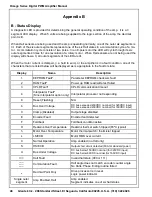
Glentek Inc. 208 Standard Street, El Segundo, California 90245, U.S.A. (310) 322-3026
60
Omega Series Digital PWM Amplifier Manual
Grounding
High frequency (HF) grounding is different from safety grounding. A long wire is sufficient for a safety
ground, but is completely ineffective as a HF ground due to the wire inductance. As a rule of thumb, a
wire has an inductance of 8 nH/in regardless of diameter. At low frequencies it acts as constant im-
pedance, at intermediate frequencies as an inductor, and at high frequencies as an antenna. The use
of ground straps is a better alternative to wires. However the length to width ratio must be
5:1,
or bet-
ter yet 3:1, to remain a good high frequency connection.
The ground system’s primary purpose is to function as a return current path. It is commonly thought of
as an equipotential circuit reference point, but different locations in a ground system may be at different
potentials. This is due to the return current flowing through the ground systems finite impedance. In a
sense, ground systems are the sewer systems of electronics and as such are sometimes neglected.
The primary objective of a high frequency ground system is to provide a well-defined path for HF cur-
rents and to minimize the loop area of the HF current paths. It is also important to separate HF
grounds from sensitive circuit grounds. “Single Point Ground Types” shows single point grounds for
both series (daisy chain) and parallel (separate) connections. A single point, parallel connected
ground system is recommended.
A ground bus bar or plane should be used as the “single point” where circuits are grounded. This will
minimize common (ground) impedance noise coupling. The ground bus bar (GBB) should be con-
nected to the AC ground, and if necessary, to the enclosure. All circuits or subsystems should be con-
nected to the GBB by separate connections. These connections should be as short as possible and
straps should be used when possible. The motor ground conductor must return to the ground terminal
on the drive, not the GBB.
Shielding and Segregation
The EMI radiating from the drive enclosure drops off very quickly over distance. Mounting the drive in
an enclosure, such as an industrial cabinet, further reduces the radiated emissions. The cabinet
should have a high frequency ground and the size of the openings should be minimized. In addition,
the drive is considered an “open” device that does not provide the proper IP rating for the environment
in which it is installed. For this reason the enclosure must provide the necessary degree of protection.
An IP rating or Nema rating (which is similar to IP) specifies the degree of protection that an enclosure
provides.
The primary propagation route for EMI emissions from a drive is through cabling. The cables conduct
the EMI to other devices, and can also radiate the EMI. For this reason, cable segregation and shield-
ing are important factors in reducing emissions. Cable shielding can also increase the level of immu-
nity for a drive. For example:
•
Shield termination at both ends is extremely important. The common misconception that
shields should be terminated at only one end originates from audio applications with frequen-
C IR C U IT
2
C IR C U IT
3
C IR C U IT
1
C IR C U IT
2
C IR C U IT
1
C IR C U IT
3
Figure 3-Single Point Ground Types
Summary of Contents for Omega SMC9930
Page 73: ...Glentek Inc 208 Standard Street El Segundo California 90245 U S A 310 322 3026 73 Appendix K...
Page 75: ...Glentek Inc 208 Standard Street El Segundo California 90245 U S A 310 322 3026 75 Appendix K...
Page 77: ...Glentek Inc 208 Standard Street El Segundo California 90245 U S A 310 322 3026 77...
















































